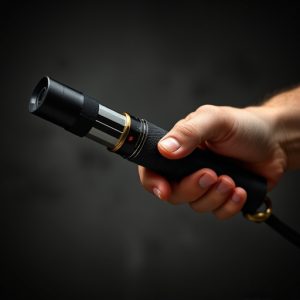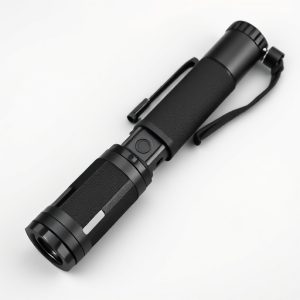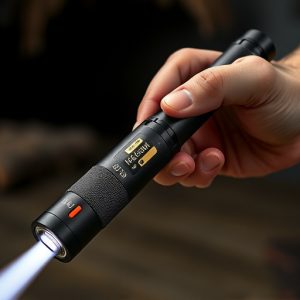Optimizing Law Enforcement with Self-Defense Expandable Batons: A Comprehensive Guide
Self-defense expandable batons are vital tools for modern law enforcement, offering a non-lethal al…….
Self-defense expandable batons are vital tools for modern law enforcement, offering a non-lethal alternative to firearms that enhances public safety. These multi-segment batons are discreet when stored but extend quickly into a longer form for use in various situations, from crowd control to subduing attackers. Made of durable materials like aerospace aluminum, they feature a reliable locking mechanism and safety features that prevent accidental collapses and reduce injury risk. Advanced models incorporate LED illumination, anodized finishes, training modes, and some even have smart technology capabilities for data logging. Law enforcement professionals must undergo specialized training to effectively and responsibly use these batons within departmental policies and legal frameworks, ensuring they are prepared for dynamic field conditions. The choice of baton model should consider the physical attributes of officers and typical confrontational scenarios, with regular maintenance a key factor in maintaining their efficacy. By adhering to clear protocols and best practices, law enforcement can effectively employ expandable batons as part of their self-defense strategies, promoting officer safety, public order, and community trust.
Law enforcement agencies worldwide continually seek to enhance officer safety and effectiveness through advanced gear. Among these tools, self-defense expandable batons stand out for their versatility and utility in various situations. This article delves into the critical role of these batons within law enforcement arsenals, examining their key features, the importance of proper training, and offering a comparative analysis of leading brands and models. Additionally, it provides best practices for integrating expandable batons into daily operations, ensuring officers are well-equipped to maintain public safety and personal protection.
Understanding the Role of Self-Defense Expandable Batons in Law Enforcement Gear
Self-defense expandable batons serve as a versatile and effective tool in the arsenal of law enforcement gear, offering officers an additional means to maintain public safety while on duty. These collapsible batons are designed with a multi-segment structure that allows them to be compact for storage yet extend to a formidable length when deployed. This feature ensures that officers can carry them without significant space constraints, making them an ideal complement to traditional sidearms and Tasers.
The effectiveness of self-defense expandable batons lies in their ability to control situations where lethal force would be disproportionate or unnecessary. They offer a balance between the immediate deterrence provided by firearms and the non-lethal intervention of hand-to-hand combat. Law enforcement personnel can use these batons for crowd control, to neutralize threats at a distance, or to subdue an assailant without causing permanent injury. The training required to handle expandable batons effectively is critical, as it encompasses not only the physical techniques but also the legal implications of their use in various scenarios. This training ensures that officers can rely on these tools confidently and judiciously within the scope of their duties.
Key Features and Specifications of Modern Expandable Batons
Modern expandable batons are a testament to the ingenuity and innovation within law enforcement gear, serving as both a deterrent and a reliable self-defense tool. These batons are designed with key features that enhance their effectiveness while remaining compact and easy to carry. Constructed from high-strength aerospace aluminum or other durable materials, they can be quickly extended to varying lengths, typically ranging from 16 to 26 inches, allowing officers to adapt to different situations. The locking mechanism within these batons ensures a secure extension without the risk of sudden collapse during use.
The expandable nature of these batons makes them an ideal choice for officers who prioritize both space-efficiency and versatility in their self-defense expandable baton. They often come with a foam or rubber coating, which not only offers a non-slip grip but also cushions impact to minimize injury to subjects or bystanders. This is crucial when considering the necessity of maintaining control while subduing a threat. Additionally, many modern expandable batons are equipped with LED lights, providing illumination in low-light conditions and further increasing the safety of both law enforcement personnel and the public. Other specifications may include anodized finishes for corrosion resistance, multiple training modes, and even smart technology features that can track usage or collect data for forensic analysis.
The Importance of Baton Training and Protocols for Officers
Law enforcement officers often face unpredictable situations that require them to be adept at self-defense and crowd control. Incorporating an expandable baton into their gear is a strategic decision that enhances their defensive capabilities without resorting to lethal force immediately. Effective baton training is paramount; it ensures officers are proficient in using the baton as an extension of their physical prowess, allowing for precise strikes and effective distance control during confrontations. The expandable nature of these batons provides a versatile tool that can be easily stored yet swiftly deployed to incapacitate a threat or maintain a safe personal boundary. Protocols governing the use of batons are equally important, as they dictate appropriate application in various scenarios, from managing aggressive individuals to navigating crowd control situations. These protocols also safeguard against misuse and help uphold the integrity of the law enforcement’s role as protectors of public safety. By adhering to rigorous training and stringent use-of-force policies, officers can effectively employ expandable batons as a vital component of their self-defense arsenal, ensuring both personal and public safety in dynamic environments.
A Comparative Analysis of Different Brands and Models of Expandable Batons
When it comes to self-defense, law enforcement professionals require reliable gear that can be both effective and convenient to carry. Expandable batons serve as a versatile tool for officers in various situations, offering a balance between reach and control. Among the plethora of brands and models available, some stand out for their quality, durability, and effectiveness. For instance, the Smith & Wesson Expandable Baton is a favorite due to its sturdy construction and reliable performance. It features a high-strength aerospace aluminum design that extends quickly with a push of the button, ensuring a rapid response to threats. On the other hand, the DefTech Baton X10 offers a sleeker profile when retracted, making it an ideal choice for officers who prioritize minimal bulk in their gear. Its rapid deployment and locking mechanism allow for swift and precise maneuvers during confrontations.
Another notable option is the Security Equipment Corporation’s Pro-Defense baton, which is known for its lightweight yet robust nylon construction. This model stands out for its ability to withstand intense conditions without failure, a critical feature for long-term use in the field. Each of these models excels in different aspects of performance and durability, catering to the diverse needs of law enforcement personnel. When selecting an expandable baton, it is important to consider factors such as ease of operation, the material’s resilience, weight distribution, and the overall length when extended. These attributes play a crucial role in determining how well a baton will serve as a self-defense tool in real-world scenarios. Law enforcement agencies must carefully evaluate each model to determine which expandable baton aligns best with their operational requirements and the safety of both officers and the public they serve.
Best Practices for Integrating Expandable Batons into Daily Law Enforcement Operations
Law enforcement officers often face dynamic and unpredictable situations that necessitate effective self-defense measures. Expandable batons serve as a valuable tool within this realm, offering a balance between portability and utility. When integrating expandable batons into daily operations, it is crucial to establish clear protocols for their use. Firstly, officers should receive comprehensive training on the proper deployment and handling of these devices. This training must encompass scenarios that range from crowd control to personal self-defense situations. The training should also cover the legal implications of using expandable batons, ensuring compliance with departmental policies and applicable laws.
Furthermore, the selection of appropriate baton models should be based on factors such as the average stature of officers in the force and the types of encounters they are likely to encounter. The best practices for integration also include regular maintenance checks to ensure the batons remain in optimal condition. Additionally, policies must dictate when and how expandable batons can be deployed, emphasizing their role as a last resort in self-defense or controlling an individual who poses a threat. By adhering to these best practices, law enforcement agencies can effectively integrate expandable batons into daily operations, enhancing officer safety and ensuring the protection of public peace while upholding the principles of community trust and accountability.


